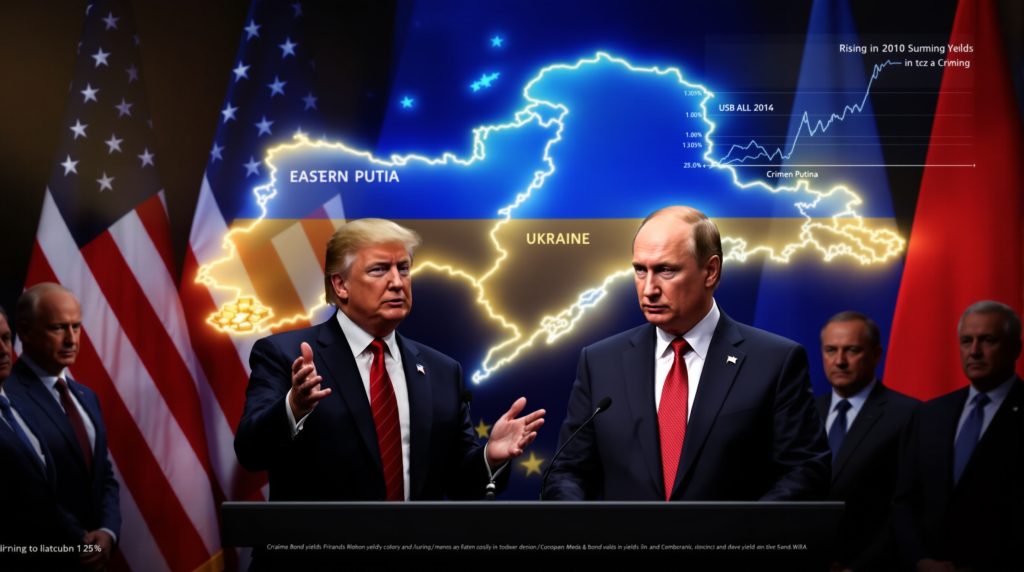Meeting Between Trump and Putin in Alaska: Geopolitical Implications and Economic Outlook
The recent diplomatic engagement between former President Donald Trump and Russian President Vladimir Putin in Alaska has captured international attention, representing a potential shift in US-Russia relations with far-reaching consequences. This high-profile summit centered on addressing the ongoing Ukraine conflict through direct negotiation rather than continued military engagement, marking a significant departure from previous policy approaches.
What Happened at the Trump-Putin Alaska Meeting?
Key Points of the Alaska Summit
The meeting between the two leaders focused primarily on finding a resolution to the Ukraine conflict. Trump's approach demonstrated a clear pivot from established policies, emphasizing direct diplomacy over continued military support. Both leaders expressed a desire to disentangle from the situation, with Trump reportedly viewing the conflict as a failed policy requiring a new direction.
The summit's format allowed for extensive private discussions between the leaders, with limited media access. This approach enabled frank conversations about sensitive geopolitical issues without immediate public scrutiny or posturing.
Stated Objectives and Outcomes
The discussions reportedly yielded a general understanding regarding potential peace terms. Trump's position appears to center on ending American involvement in the conflict, which he has characterized as an unnecessary foreign entanglement. Putin, speaking from a position of relative battlefield strength, presented what the Russian side considers reasonable terms for cessation of hostilities.
The subsequent press conference was notably led by Putin, suggesting confidence in the trajectory of negotiations. While specific agreements weren't publicly detailed, the tone indicated progress toward a framework for potential conflict resolution.
European Response to the Meeting
European leaders have expressed significant alarm regarding the meeting and its implications. Multiple European officials made diplomatic trips to Washington in attempts to dissuade Trump from withdrawing support for Ukraine, arguing that sustained pressure on Russia remains essential for regional security.
These diplomatic efforts appear to have gained little traction, as Trump tariffs impact seem to have reinforced his commitment to his approach regardless of European concerns. This development has created tension within the NATO alliance, with European capitals concerned about potential abandonment of Ukraine and the precedent it might set for future conflicts.
How Does This Meeting Impact the Ukraine Conflict?
Potential Peace Terms Discussed
The peace framework likely centers around several key conditions: Ukraine adopting neutral status outside NATO, Russia maintaining control of certain eastern territories (particularly two oblasts in the Donbas region), formal recognition of Russian sovereignty over Crimea, and binding treaty commitments preventing Ukraine from joining NATO in the future.
These terms align with Russia's consistent demands throughout the conflict and reflect the current military reality on the ground. For Ukraine, such terms would represent significant territorial concessions in exchange for ending active hostilities.
Zelensky Meeting and U.S. Position
Following the Alaska summit, Trump was scheduled to meet with Ukrainian President Zelensky. Reports suggest the message to Ukraine would be straightforward: either accept the negotiated framework with Russia or face diminished American support. This presents Ukraine with an extremely difficult strategic choice between territorial concessions or continuing conflict with potentially reduced international backing.
The diplomatic pressure places Ukraine in a precarious position, as its military capabilities remain heavily dependent on Western support, particularly American weapons systems and intelligence.
Military Situation on the Ground
The current battlefield situation favors Russian forces, which have secured incremental territorial gains along the eastern front. This position of relative strength gives Russia little incentive to accept temporary ceasefires without permanent political concessions from Ukraine.
European proposals for interim arrangements, including peacekeeping forces or temporary cessations of hostilities, have reportedly been rejected by Russia. The Russian position appears to view such temporary measures as merely providing Ukraine opportunity to rearm and reorganize rather than steps toward permanent resolution.
What Are the Historical Contexts Behind This Conflict?
Origins of the Ukraine Crisis
The current conflict has deep historical roots, particularly in the 2014 political upheaval that saw significant civil unrest culminating in government change. This period marked a pivotal reorientation in Ukraine's geopolitical alignment, with increased Western influence and decreased Russian sway over Ukrainian affairs.
The subsequent Russian annexation of Crimea and support for separatist movements in eastern Ukraine established the territorial disputes that continue to define the conflict. These actions reflected Russia's determination to maintain strategic depth and prevent NATO expansion to its immediate borders.
U.S. Strategic Interests in the Region
From a strategic perspective, Ukraine represents a critical buffer zone between Russia and NATO members. American policy has historically sought to limit Russian influence in former Soviet states while expanding Western democratic and economic systems eastward.
This approach reflects broader containment strategies dating back to Cold War frameworks, updated for contemporary geopolitical realities. The bipartisan consensus supporting Ukrainian independence has now potentially fractured, signaling a possible realignment of American strategic priorities.
Russian Security Concerns
Russia has consistently framed its actions in Ukraine as defensive measures to secure its western borders rather than expansionist ambitions. From Moscow's perspective, NATO expansion eastward and Western influence in Ukraine constitute direct security threats requiring countermeasures.
This security-focused narrative emphasizes Russia's historical experiences with invasions from the west and the strategic importance of maintaining buffer territories. While Western analysts often dismiss these concerns as pretexts for territorial expansion, they represent genuine security calculations within Russian strategic thinking.
What Economic Implications Could Result from This Meeting?
Global Financial Market Concerns
The geopolitical shifts signaled by this meeting with Donald Trump and Vladimir Putin in Alaska occur against a backdrop of significant economic challenges. Global financial markets face potential instability due to rising long-term bond yields across major economies, potentially signaling the conclusion of a prolonged credit bubble.
These rising yields could trigger substantial market corrections in equity and real estate markets, which have been artificially supported by historically low interest rates. The combination of geopolitical uncertainty and financial market stress creates heightened vulnerability in global economic systems.
Currency Stability Issues
The combination of geopolitical uncertainty and financial market stress could accelerate concerns about currency stability. Major currencies with significant foreign ownership, particularly the U.S. dollar and British pound, could experience selling pressure if international investors seek to reduce exposure during market turbulence.
Currency volatility could further complicate international trade and investment flows, particularly for emerging market economies dependent on dollar-denominated financing. These pressures might accelerate discussions about alternative reserve currency arrangements among nations seeking to reduce dollar dependence.
Defense Spending Trends
One economic sector likely to see continued growth regardless of market conditions is defense spending. NATO countries have faced increasing pressure to raise defense budgets to at least 2% of GDP, with some nations considering targets as high as 5% by 2030.
This represents a significant shift in fiscal priorities, especially for European nations already facing budget constraints. Increased defense expenditures will require either reduced spending in other sectors or higher taxation, creating difficult political choices for European governments already dealing with social welfare commitments.
How Might This Affect Global Financial Markets?
Bond Market Warning Signs
Long-term bond yields across major economies (U.S., UK, Germany, Japan) show potential breakout signals toward higher levels. This trend could push yields on U.S. Treasury bonds toward 8-10%, creating significant pressure on financial assets and potentially triggering capital flight from dollar-denominated investments.
The impact would be particularly severe for highly leveraged sectors that have benefited from low-interest environments. Government bond markets serve as the foundation for all other asset pricing, meaning disruptions at this level ripple throughout the entire financial system.
Equity Market Vulnerabilities
The relationship between long-term bonds and equity valuations appears more stretched than at any previous point in financial history, suggesting equity markets may be particularly vulnerable to correction. Foreign ownership of U.S. equities amounts to approximately $15.5 trillion, representing capital that could exit rapidly during a market crisis.
This potential outflow represents a significant risk to market stability, as foreign investors might prioritize capital preservation over long-term holdings during periods of heightened uncertainty. The velocity of such capital movements could overwhelm normal market mechanisms.
Precious Metals as Safe Havens
In this environment of potential currency instability and market correction, gold and silver may function as safe-haven assets. Current gold prices analysis suggests ownership represents less than 0.5% of global investment portfolios, indicating significant room for increased allocation if investors seek protection from currency devaluation and credit market stress.
Historical patterns indicate precious metals often outperform during periods of geopolitical uncertainty and financial market stress, particularly when confidence in paper currencies diminishes. Even a modest reallocation of global investment capital toward precious metals could drive substantial price appreciation.
What Does This Mean for U.S. Foreign Policy?
Shift in Strategic Priorities
The meeting signals a potential significant realignment in U.S. foreign policy priorities, moving away from the Ukraine conflict to focus on other strategic concerns. This reorientation could include renewed focus on Iran and the Balkans as areas of geopolitical interest, representing a major redistribution of American strategic resources and attention.
Such a shift would mark a departure from bipartisan consensus that has characterized American policy toward Russia since 2014. This realignment reflects a more transactional approach to international relations that prioritizes specific American interests over broader ideological commitments.
NATO Alliance Dynamics
While the meeting has created tension with European NATO allies, it doesn't necessarily signal abandonment of these alliances. Rather, it represents a different approach to managing these relationships, with the U.S. potentially expecting European nations to assume greater responsibility for their own defense while maintaining alliance structures.
This evolution in alliance management creates challenges for European partners who have relied on American security guarantees since World War II. The adjustment period will likely involve difficult negotiations about burden-sharing and strategic autonomy within the alliance framework.
Deep State Resistance
Implementation of any major policy shift faces potential resistance from established institutional actors within intelligence services and the Department of Defense. These elements of government may resist acknowledging policy failures or accepting strategic retreats, creating internal tension within the administration as it attempts to execute its foreign policy vision.
This institutional resistance reflects bureaucratic inertia and genuine policy disagreements rather than conspiratorial motives. Managing this internal resistance represents a significant challenge for any administration attempting major foreign policy realignments.
FAQ: Trump-Putin Alaska Meeting
Why did Trump agree to meet with Putin during this time?
Trump has consistently stated his desire to end U.S. involvement in the Ukraine conflict, viewing it as a failed policy of the previous administration. The meeting represents a direct diplomatic approach to resolving the situation through negotiation rather than continued military support.
This approach aligns with his stated "America First" foreign policy vision that prioritizes specific American interests over broader international commitments. The timing suggests a desire to establish diplomatic momentum early rather than allowing the conflict to continue indefinitely.
What territories is Russia likely to retain in any peace agreement?
Russia is primarily focused on securing two eastern oblasts (provinces) in Ukraine, though they have been fighting for control of four such regions. Additionally, formal recognition of Crimea as Russian territory remains a non-negotiable demand in any potential peace agreement.
These territorial claims reflect both strategic military considerations and domestic political imperatives for the Russian government, which has invested significant national resources and prestige in the conflict. Any agreement that doesn't address these territorial claims would likely be rejected by Moscow.
How have European leaders responded to this diplomatic initiative?
European leaders have expressed significant concern and opposition to the meeting and its potential outcomes. Many traveled to Washington to discourage Trump from pursuing this diplomatic track, arguing instead for continued pressure on Russia, but these efforts appear to have been unsuccessful.
This response highlights fundamental differences in strategic assessment between European capitals and the current American approach. European leaders fear that accommodating Russian territorial demands creates dangerous precedents that could threaten security across the continent.
What are the main conditions Russia seeks for ending the conflict?
Russia's primary demands include: Ukraine becoming a neutral state, recognition of Russian control over certain eastern territories, acknowledgment of Crimea as Russian territory, and a binding commitment that Ukraine will not join NATO.
These conditions have remained consistent throughout the conflict, reflecting core Russian security concerns and territorial ambitions. From Moscow's perspective, these terms represent minimum requirements for resolving the conflict rather than starting points for negotiation.
How might this affect global financial markets?
The geopolitical shifts come amid warnings of potential financial market instability, with rising long-term bond yields potentially triggering significant corrections in equities and real estate. This could accelerate movement from paper assets to physical assets like precious metals as safe havens.
Market participants are particularly concerned about the intersection of geopolitical uncertainty with already stretched asset valuations across multiple markets. This combination creates heightened vulnerability to rapid market adjustments, especially if institutional investors begin defensive repositioning simultaneously.
The Future of U.S.-Russia Relations
Potential Areas of Cooperation
Despite tensions over Ukraine, the meeting may open possibilities for cooperation in other areas of mutual interest. Both nations face common challenges including terrorism, managing relations with China, and addressing regional stability issues that could provide grounds for pragmatic engagement.
Energy policy represents another potential area for collaboration, particularly given both nations' status as major energy producers. Cooperation on stabilizing global energy markets could benefit both economies while providing a foundation for improved relations in other domains.
Ongoing Points of Contention
Significant differences remain between U.S. and Russian positions on many issues, including human rights, democratic governance, and spheres of influence. These fundamental disagreements will continue to create friction even if the Ukraine situation is resolved through negotiation.
Tariffs' market impact alongside cyber operations and election interference allegations also remain contentious issues that complicate bilateral relations. Establishing clear boundaries and expectations in these domains represents a significant challenge for future diplomatic engagement.
Long-term Strategic Implications
The meeting potentially signals a recalibration of U.S. strategic priorities, moving away from direct confrontation with Russia over Ukraine toward other areas of concern. This shift could represent a more realist approach to foreign policy that prioritizes core national interests over ideological commitments.
Such a reorientation would have significant implications for international relations more broadly, potentially signaling reduced American willingness to commit resources to conflicts perceived as peripheral to core security interests. This could accelerate trends toward regional power consolidation and multipolarity in the international system.
A Potential Turning Point in International Relations
The Alaska meeting between Trump and Putin represents a potentially significant inflection point in international relations, particularly regarding the Ukraine conflict. By pursuing direct diplomacy despite European objections, Trump has signaled willingness to break with established policy frameworks in search of pragmatic solutions.
The outcome of this diplomatic initiative remains uncertain, particularly given domestic political considerations in both countries and the complex realities on the ground in Ukraine. However, as ABC News reported, the meeting itself marks a clear departure from previous approaches and could herald a broader realignment of international relationships and priorities.
Against the backdrop of potential financial market instability and currency concerns, these geopolitical shifts add another layer of uncertainty to an already complex global situation. Furthermore, recent US mineral production order initiatives demonstrate how resource security is becoming increasingly intertwined with foreign policy decisions. The coming months will likely reveal whether this diplomatic gambit results in meaningful conflict resolution or merely represents another chapter in the ongoing geopolitical competition between major powers, as NPR analysis suggests through examination of documents from the summit.
Want to Catch the Next Major Mineral Discovery?
Discovery Alert's proprietary Discovery IQ model provides immediate notifications on significant ASX mineral discoveries, turning complex geological data into actionable investment insights. Explore why historic discoveries can generate substantial returns by visiting Discovery Alert's dedicated discoveries page and position yourself ahead of the market.




